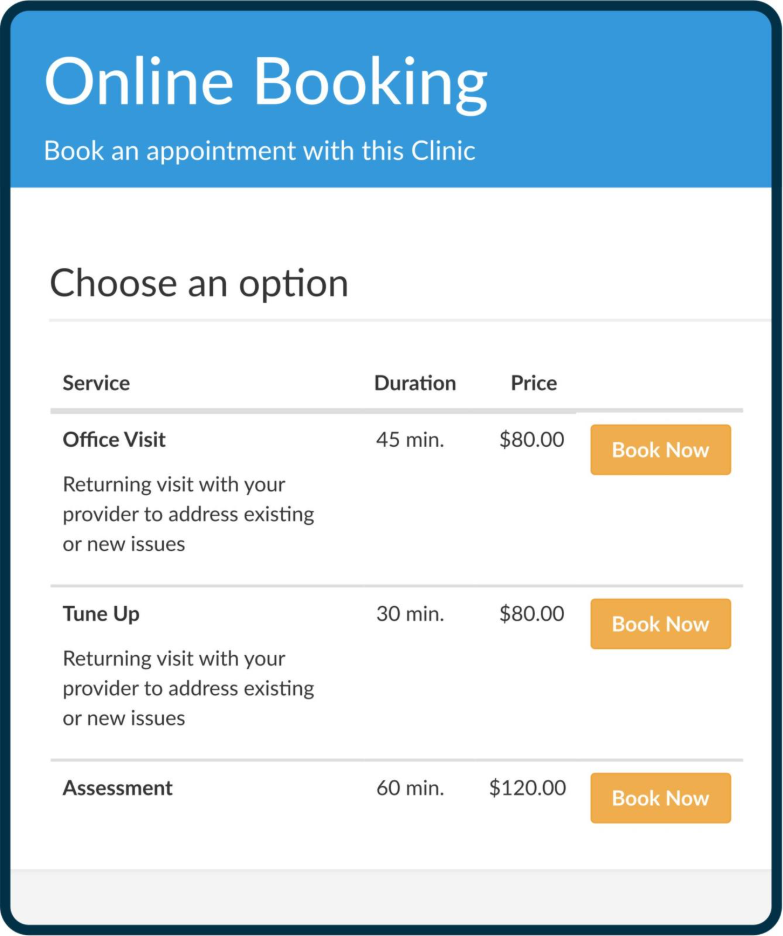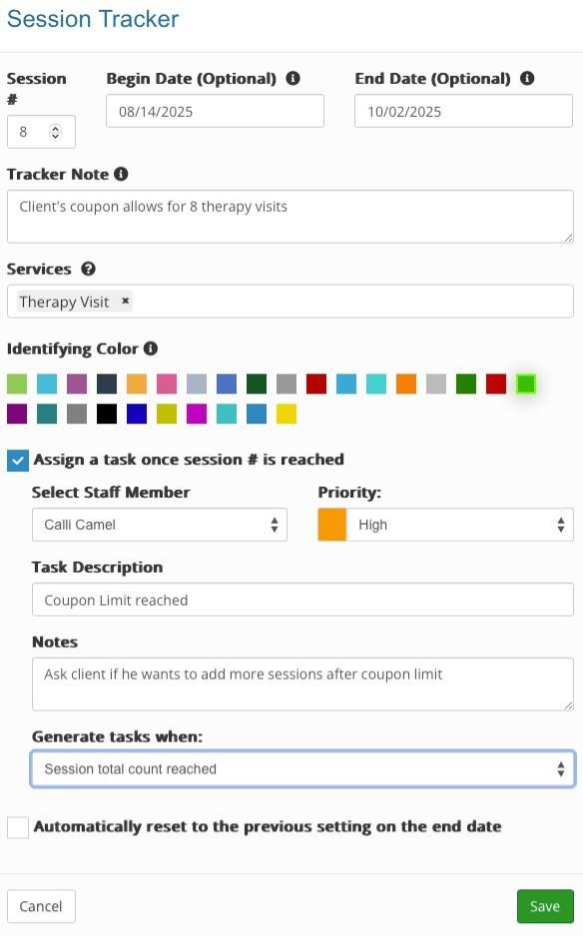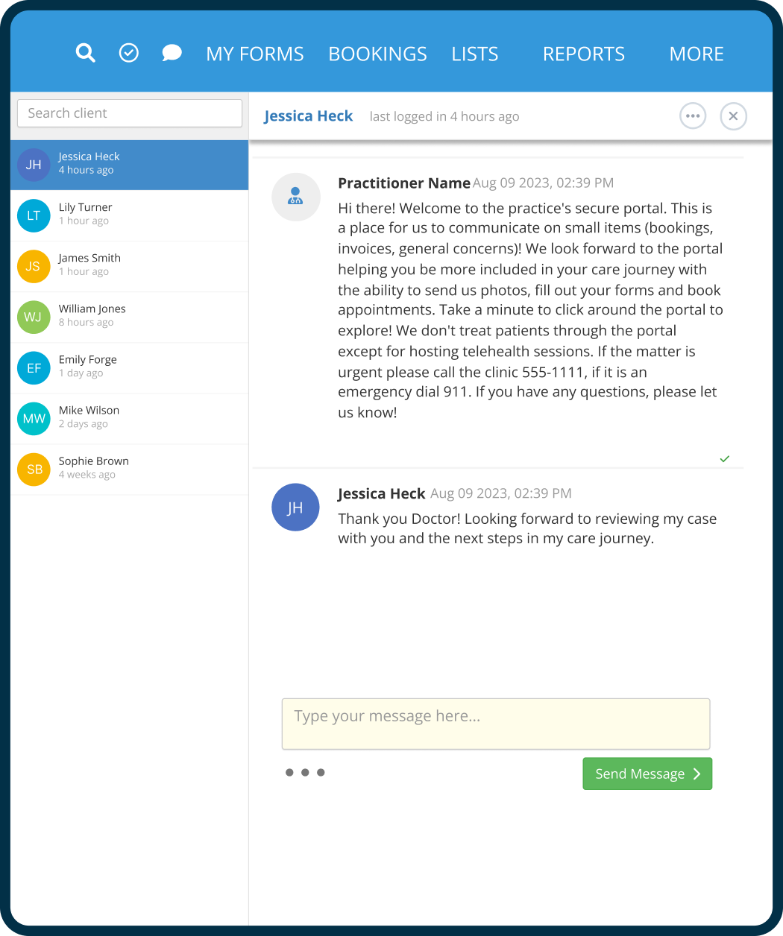Practical Tips to Streamline Workflows & Improve Patient Satisfaction
Key Takeaways
- Smooth scheduling, intake, and billing processes have the biggest impact on patient satisfaction.
- Clear communication among staff prevents errors and builds patient trust.
- Digital tools like online scheduling, follow-ups, and portals save time for both patients and providers.
- Consistent workflows create dependable, positive experiences that keep patients engaged.
- PracticeQ brings everything together in one platform, helping your team deliver care that feels organized, efficient, and personal.
Most healthcare providers chose this work for the same reason: to make a difference in someone’s life. You listen, guide, and help patients find stability in moments that feel anything but stable. But somewhere between intake forms and billing questions, the focus on care can get buried under the weight of admin work.
Improving patient satisfaction isn’t about doing more. It’s about removing what gets in the way of meaningful care.
In this article, we’ll look at ten common problems that affect patient satisfaction and practical ways to fix them in your practice.
Why Improving Patient Satisfaction Matters
Patient satisfaction shapes more than how people feel about your practice. It affects performance, growth, and the trust that keeps patients coming back.
Here’s why it matters:
- Better retention and referrals. Patients who feel cared for return and recommend your practice to others. Positive experiences remain the strongest driver of word-of-mouth growth.
- Financial performance. One study of more than 130 hospitals found that when patient experience improved one year, those same hospitals saw higher revenue and lower operating costs the next. The link was clear, even without financial incentives for experience scores.
- Reputation. Every smooth interaction strengthens your reputation and encourages future visits. Satisfied patients become advocates, often before you even ask.
The bottom line: improve the experience, and you improve performance, reputation, and the long-term health of your practice.
10 Everyday Patient Problems You Can Fix
Every practice has a few pain points that slow the day down. From the first call to the final bill, patients notice the friction, even if they never bring it up. Over time, those moments shape how they feel about your care.
Fortunately, it doesn’t take an overhaul to make things run better. A few smart changes can ease the pressure on your team and make every visit smoother for patients.
Here’s where to start.
Long Wait Times and Scheduling Friction
Nothing tests patience like waiting, whether it’s on hold, in the lobby, or for an opening that never comes. It’s the moment patients start doubting the rest of their experience.
With online scheduling, patients can see real availability, book in real time, and get automatic reminders that keep the day on track. Shorter waits and fewer no-shows mean your team stays focused on care instead of catch-up.

Repetitive Paperwork and Intake Fatigue
Patients don’t expect perfection, but they do expect progress. Filling out the same information visit after visit tells them your systems aren’t connected—or worse, that their time isn’t valued. It’s a small problem that leaves a big impression.
Digital intake forms collect data once and feed it straight into the patient record. Updates take seconds instead of minutes, and staff don’t waste time retyping what patients already provided. It’s a simple change that clears space for better care.
Poor Communication Between Staff and Providers
Patients can tell when your team isn’t aligned. Mixed messages can quickly lead to confusion and doubt.
Here’s how you can stay in sync:
- Keep all updates in the same record so every staff member sees the same details in real time.
- Use PracticeQ’s secure internal messaging for quick questions or handoffs instead of relying on email.
- Assign tasks and comments within the platform to track what’s done and what still needs attention.
When communication lives in one system, nothing gets lost, and patients feel the consistency in their care.
Unclear Billing or Pricing
Few things are more frustrating for patients than not knowing what they owe or why. Confusing statements and surprise charges can make even a good visit feel stressful. It’s discouraging for patients and draining for staff who spend hours sorting out questions that could’ve been avoided.
Most of these issues can be solved with clear communication. Share cost estimates before appointments and make sure staff can explain them confidently.
With PracticeQ, patients can check balances, view invoices, and pay online at their convenience. Clear, accessible billing turns a point of tension into a moment of trust, and that trust lasts long after payment is made.
Missed Follow-Ups and Post-Visit Confusion
Unclear next steps can undo an otherwise great visit. Patients leave confident, then wait for a call that never comes or results they can’t find. That silence feels like indifference, even when it’s just a workflow issue.
You can close that gap with small, consistent actions:
- Send automatic follow-up reminders through PracticeQ so patients know when to return or schedule their next appointment.
- Use secure messaging to share test results or instructions without another phone call.
- Keep post-visit notes and recommendations in one record so anyone on your team can answer patient questions confidently.
When communication continues after the visit, patients stay engaged and trust that you’re still paying attention.
Appointment Rescheduling Hassles
Every practice knows the scramble that happens when a patient needs to move an appointment. From missed voicemails to unfilled appointment slots, it’s a real problem that drains time and revenue.
The answer is to make rescheduling simple. When patients can see open times, make quick changes, and confirm without calling the front desk, schedules stay accurate and staff stay focused. Plus, PracticeQ keeps everything updated in real time, so rescheduling stops being a daily fire drill.
Insurance Coverage Confusion
You can do everything right during a visit and still lose time on the back end if coverage isn’t clear. If a claim bounces or coverage isn’t checked correctly, your team can waste hours fixing something that could’ve been verified upfront. PracticeQ integrates with TriZetto and Office Ally to check eligibility automatically and flag issues before the appointment. It’s one of the easiest ways to prevent billing disputes and protect patient trust.
Inconsistent Staff Interactions
Every patient has a story about “that one person” who made their visit harder than it needed to be. Maybe it was a rushed check-in, short reply, or follow-up that never came. You can plan for consistency, but one off interaction can undo ten good ones.
Here’s how to make staff interactions more consistent:
- Keep short notes in PracticeQ after each patient touchpoint so the next team member has context.
- Spend five minutes in weekly huddles reviewing one real example of great communication.
- Build clear visit steps in PracticeQ so everyone handles intake, handoffs, and follow-ups the same way.
When every interaction feels familiar and dependable, patients stop thinking about who’s behind the desk and start trusting the entire practice.
Lack of Progress Visibility
If your patients can’t see how far they’ve come, they start to lose momentum. Progress that isn’t visible can feel like progress that isn’t happening, and that’s when patients start to drift away. The key is giving them a clear view of their care and keeping your team connected at every step.
- Use the Patient Portal in PracticeQ to share updates, completed sessions, and next steps so patients always know what’s ahead.
- Collect short pre-visit updates through PracticeQ Forms to keep records current without adding extra work.
- Enable Session Trackers to flag milestones automatically, so your team knows when to check in and celebrate progress.
When patients can see their improvement and your team stays in sync, care feels continuous and your outcomes show it.

Limited Access to Convenient Communication Channels
These days, patients already use digital tools comfortably in their daily lives, and research shows they’re increasingly open to using those same tools to communicate with providers and manage their care. They’re ready for more flexible options; it’s up to your practice to meet them there.
If your practice only communicates by phone, you’re making connection harder than it needs to be. Text reminders, portal messages, and chat options through PracticeQ give patients simple ways to stay in touch and your staff fewer calls to return. The easier it is to reach you, the easier it is for patients to stay engaged.

How PracticeQ Helps Improve Patient Satisfaction
Patient satisfaction doesn’t hinge on one interaction. From scheduling to billing, it’s the small moments that shape how patients feel about their care and how smoothly your team can deliver it.
With PracticeQ, your practice can create a seamless patient experience from start to finish:
- Reduce wait times and prevent no-shows with flexible online scheduling
- Replace repetitive paperwork with easy digital intake forms
- Build trust through clear, upfront billing
- Keep patients engaged with ongoing communication between visits
At the end of the day, when your practice runs efficiently and patients feel cared for at every step, everyone wins.
Frequently Asked Questions
What are the biggest factors in improving patient satisfaction?
The top factors include communication quality, ease of scheduling, billing transparency, and reduced wait times.
How can technology help improve patient satisfaction?
Digital tools like online booking, portals, and automated reminders make care more accessible and transparent.
How can practices measure patient satisfaction?
Use surveys, feedback forms, and online reviews to gather insights and identify recurring issues.
Start your free trial today and see how PracticeQ simplifies operations and elevates the patient experience.
Alexander, K. E., Ogle, T., Hoberg, H., Linley, L., & Bradford, N. (2021). Patient preferences for using technology in communication about symptoms post hospital discharge. BMC Health Services Research, 21(1). https://doi.org/10.1186/s12913-021-06119-7
Cassio. (2025, August 1). How to Modernize for a Truly Patient-Centered Practice. PracticeQ. https://www.practiceq.com/resources/how-to-modernize-truly-patient-centered-practice
Giese, A., Khanam, R., Nghiem, S., Rosemann, T., & Havranek, M. M. (2023). Patient-reported experience is associated with higher future revenue and lower costs of hospitals. The European Journal of Health Economics, 25(6). https://doi.org/10.1007/s10198-023-01646-y
Milligan, S. (2024, February 13). Understanding the Financial Impact of Patient Satisfaction Scores. Ensemble Health Partners. https://www.ensemblehp.com/blog/financial-referral-patient-satisfaction-scores/


